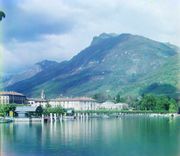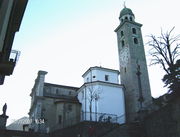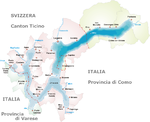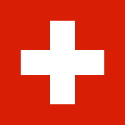Lugano
| Lugano | ||||||||||
|---|---|---|---|---|---|---|---|---|---|---|
_View_on_Lake_Lugano_and_Monte_San_Salvatore.jpg) |
||||||||||
|
||||||||||
| Population | 55,060 (Dec 2009)[1] | |||||||||
| - Density | 1,721 /km2 (4,456 /sq mi) | |||||||||
| Area | 32 km2 (12 sq mi) | |||||||||
| Elevation | 273 m (896 ft) | |||||||||
| Postal code | 6900 | |||||||||
| SFOS number | 5192 | |||||||||
| Mayor (list) | Giorgio Giudici (as of 2008) FDP/PRD/PLR | |||||||||
| Localities | Centro, Brè-Aldesago, Besso, Loreto, Castagnola, Cassarate, Molino Nuovo, Davesco-Soragno, Pambio Noranco, Cureggia, Breganzona, Gandria, Pazzallo, Pregassona, Viganello, Barbengo, Carabbia, Villa Luganese | |||||||||
| Surrounded by | Arogno, Bioggio, Cadro, Campione d'Italia (Italy), Canobbio, Carona, Collina d'Oro, Grancia, Lanzo d'Intelvi (Italy), Massagno, Melide, Muzzano, Paradiso, Porza, Savosa, Sorengo, Valsolda (Italy), Vezia | |||||||||
| Website | www.lugano.ch Profile (Italian), SFSO statistics |
|||||||||
 Lugano
|
||||||||||
| View map of Lugano | ||||||||||
Lugano (Lombard: Lügan) is a city of 55,060 inhabitants (as of December 2009[update]) in the city proper and a total of over 145,000 people in the agglomeration/city region, in the south of Switzerland, in the Italian-speaking canton of Ticino, which borders Italy. The city lies on Lake Lugano, and its warm summers and the fact that in recent years it has attracted an ever growing number of celebrities, entertainers and successful athletes have given it the nickname of the "Monte Carlo of Switzerland".[2][3] It is the 9th largest city of Switzerland by population.
The origin of the name is possibly the Latin word Lucus, meaning wood or sacred wood, or Gaulish locovanno "lake dweller".[4]
Contents |
History
Pre-History
The shores of Lake Lugano have been inhabited since the Stone Age. Within the modern city limits (Breganzona, Castagnola, Davesco and Gandria) a number of ground stones or quern-stones have been found. In the area surrounding Lugano, items from the Copper Age and the Iron Age have been found[5]. There are Etruscan monuments at Davesco-Soragno (5th to 2nd Century BC), Pregassona (3rd to 2nd Century BC), and Viganello (3rd to 2nd Century BC). Graves with jewelry and household items have been found in Aldesago, Davesco, Pazzallo and Pregassona along with celtic money in Viganello.
The region around Lake Lugano was settled by the Romans by the 1st Century BC. There was an important Roman city north of Lugano at Bioggio[5]. There are fewer traces of the Romans in Lugano, but several inscriptions, graves and coins indicate that some Romans lived in what would become Lugano.
Foundation of Lugano
The first written mention of a settlement at Lugano can be found in documents, which are of disputed authenticity[6], with which the Longobard king, Liutprand, ceded various assets located in Lugano to the Church of Saint Carpophorus in Como in 724. Other documents, dating from 804 and 844 refer to Lake Lugano as Laco Luanasco, and an act of 984 indicates Lugano as a market town.[6] In 874 the town was referred to as Luano, and in 1189 it became known by its present name. The town coat of arms also dates to around this time. The four letters on the coat of arms are an abbreviation of Lugano according to documents from 18 October 1208 and 14 November 1209[7]. This city was also known in the German-speaking cantons as Lowens, Lauis and Lauwis.[8]
It was the object of continuous disputes between the Dukes of Como and Milan until it became a Swiss dominion in 1513. Swiss control lasted until 1798 when Napoleon conquered the Old Swiss Confederation and created the Helvetic Republic. Under the Helvetic Republic, Lugano became the center of the Canton of Lugano.
Canton of Lugano
The canton of Lugano unified the former Landvogteien of Lugano, Mendrisio, Locarno and Valmaggia. However, as with the other cantons of the Helvetic Republic, the autonomy of Lugano was very limited, the republic having been founded by Napoleon in order further to centralise power in Switzerland. The canton was led by a Directory of five members, who appointed a "national préfet"[9].
The canton deeply divided between "patriots", supporting the Cisalpine Republic, and traditionalist "aristocrats". By 1799 riots broke out in Lugano, and the second préfet, Francesco Capra, fled the city. Power passed to a provisional government sympathetic to the Habsburgs. However, French occupation was restored in 1800[9]. Discontent continued and in early 1802 a revolt in Capriasca led to the autumn pronunciamento of Pian Povrò, which declared the independence of Lugano from the Helvetic client republic.
With the Act of Mediation, the following year, political agitation was finally quelled, as were the struggles between unionists and federalists. The canton of Lugano merged with Bellinzona creating the canton of Ticino, which endures to the present day.
Modern Lugano

Following the Second World War, and particularly during the 1960s and 70s, thanks to an abundant flow of capital from nearby Italy,[10] Lugano experienced a period of exponential growth in banking activities which led to it placing itself as the third financial centre of Switzerland,[7][11] with over 100 banking institutions present in the town.[10]
Geography
Lugano lies at the edge of Lake Lugano (Italian: Lago di Lugano or Ceresio), which is situated between the lakes Lago Maggiore and Lago di Como, south of the Alps.
The city is located where the river Cassarate enters the lake between the Brè (925m) and the San Salvatore (912m) mountains.
Demographics
| Historical populations | ||
|---|---|---|
| Year | Pop. | %± |
| 1970 | 41,331 | — |
| 1980 | 45,422 | 9.9% |
| 1990 | 46,113 | 1.5% |
| 2000 | 50,857 | 10.3% |
| 2008 | 54,437 | 7.0% |
| Source:[12] | ||
Since its union with some surrounding municipalities (Breganzona, Cureggia, Davesco-Sorengo, Gandria, Pambio-Noranco, Pazzallo, Pregassona, and Viganello) in 2004, Lugano has a population of over 54,000 and is therefore Canton Ticino's largest city.[13] This was the second major expansion after the union in 1972 with the municipalities of Brè-Aldesago and Castagnola.
The town's thriving economy provides an estimated 38,000 jobs[13], over a third of which are occupied by cross-border commuters. Business, tourism and finance constitute the backbone of the local economy. In 2000, the tertiary sector offered 90% of all jobs in Lugano, of which 75% were occupied by commuters, many of which commute from neighbouring Italy (approximately 13% of the active working population); in the same year tax revenues reached CHF 104 million, of which CHF 59 million were attributable to the banking sector. The city is Switzerland's third largest banking centre after Zurich and Geneva.[14][15] With regards to intercommunal financial equalisation, thanks to its financial strength Lugano contributes significantly to the equalisation fund.[10] The population is Italian-speaking and mainly Roman Catholic.
Economy
The airline Darwin Airline has its head office on the grounds of Lugano Airport in Agno, near Lugano.[16]
Tourism
Lugano is one of the most popular tourist destinations in Switzerland.[17] Both Lake Lugano and the surrounding mountains provide a wide variety of outdoor activities. Lugano is, also, home to a number of historic buildings and museums.
Natural sights
A very popular destination in Lugano is Lake Lugano. The lake is 48.7 square kilometers (18.8 sq mi) in size, 63% of which is in Switzerland and 37% in Italy. It has an average width of roughly 1 km (0.62 mi) and is nearly 3 km (1.86 mi) at its widest.[18] The maximum depth of the lake is 279 m (915 ft).[18] The water is generally warm with average water temperatures in the summer ranging from 19.5 °C (67.1 °F) to 24.0 °C (75.2 °F).[18] Bathing in the lake is allowed at any of the 50 or so bathing establishments located along the Swiss shores.[19] There are numerous shipyards, water taxis and boat rental sites along the lake, as well as hotels and restaurants that offer mooring.

In addition to the lake, Lugano is surrounded by mountains. The mountains provide a number of opportunities for sports or sightseeing. The area surrounding Lugano is home to over 300 km (186 mi) of mountain biking trails, the largest net of trails in Switzerland.[20] Monte Brè (925 meters (3,035 ft)) east of Lugano has had a funicular that runs up the mountain since 1912.[21] Monte Brè, which is Switzerland's sunniest spot[21], is also home to the village of Brè which is a fairly intact old village. Monte San Salvatore (912 meters (2,992 ft)) also has a funicular, with the base station located only 500 meters (1,640 ft) from the Lugano-Sud motorway exit and 5 minutes away from the Paradiso railroad station.[22] Monte San Salvatore is located on the outskirts of Lugano and provides an excellent view over the entire city.
Buildings

- St. Lawrence Cathedral (9th and 15th century)
- St. Mary of the Angels Church (16th century) with the fresco of the Christ's Passion from Bernardino Luini
- Parco civico - Villa Ciani
- Piazza della Riforma
- Villa Favorita
Museums
- Art Museum
- Museo delle Culture (Museum of Cultures)
- Cantonal Art Museum
- Foundation Aligi Sassu and Helenita Olivares
- Historical Museum
- Cantonal Museum on Natural History
- Swiss Custom Museum
- Municipal Art Museum
- Wilhelm Schmid Museum
- Gottardo Gallery
- Hermann Hesse Museum
Weather
| Climate data for Lugano | |||||||||||||
|---|---|---|---|---|---|---|---|---|---|---|---|---|---|
| Month | Jan | Feb | Mar | Apr | May | Jun | Jul | Aug | Sep | Oct | Nov | Dec | Year |
| Average high °C (°F) | 6.1 (43) |
7.8 (46) |
11.6 (52.9) |
15.1 (59.2) |
18.9 (66) |
22.9 (73.2) |
25.8 (78.4) |
24.7 (76.5) |
21.4 (70.5) |
16.5 (61.7) |
10.6 (51.1) |
7.1 (44.8) |
15.7 (60.3) |
| Average low °C (°F) | 0.1 (32.2) |
1.3 (34.3) |
3.9 (39) |
7.2 (45) |
11.0 (51.8) |
14.2 (57.6) |
16.7 (62.1) |
16.0 (60.8) |
13.3 (55.9) |
9.1 (48.4) |
4.4 (39.9) |
1.0 (33.8) |
8.2 (46.8) |
| Precipitation mm (inches) | 76 (2.99) |
71 (2.8) |
106 (4.17) |
152 (5.98) |
194 (7.64) |
171 (6.73) |
133 (5.24) |
166 (6.54) |
153 (6.02) |
140 (5.51) |
120 (4.72) |
63 (2.48) |
1,545 (60.83) |
| Avg. precipitation days | 6 | 7 | 8 | 10 | 13 | 11 | 9 | 10 | 8 | 8 | 8 | 6 | 104 |
| Source: World Weather Information Service[23] | |||||||||||||
Education and research
- Università della Svizzera italiana: Lugano is the home of the faculties of informatics, economics, and communication sciences.
- Swiss National Supercomputing Centre: an autonomous unit of ETH Zurich that focuses on high-performance computing.
- Dalle Molle Institute for Artificial Intelligence: a non-profit oriented research institute for artificial intelligence, affiliated with both the Università della Svizzera Italiana and SUPSI.
- Franklin College Switzerland: an American and Swiss accredited liberal arts college.
- The American School In Switzerland: an international secondary school.
- SUPSI: University of Applied Science of Southern Switzerland.
- CSIA, (Centro scolastico per le industrie artistiche): A school after secondary education for studying art and design.
Transport
Lugano is located along the A2 motorway, a part of the European route E35 which over 1,600 km (994 mi) between Amsterdam and Rome.
The yellow "Post" buses, part of the Autopostale service, offer 64 regional public service lines, as well as five urban lines, travels an estimated 7.9 million kilometres and transports 7 million passengers annually. Its network is also integrated with other modes of transport, such as the funiculars and the federal railways, and therefore regularly announces competitive offers on tourist excursions.
Its Palm Express service connects Lugano to St. Moritz. The AutoPostale station and ticket office is located at Via Balestra 4 in the centre of Lugano. The inner city TPL buses, Trasporti pubblici luganesi, connect the centre with the suburbs; the Autolinee regionali luganesi buses, connect Lugano with the towns of Canobbio, Davesco, Lamone, Sonvico and Tesserete.
Lugano is served by Lugano Airport, in the nearby municipality of Agno. Darwin Airline, Flybaboo and Swiss Airlines operate to Lugano Airport. While there is limited service to Lugano's airport, Milan’s airports are around 60 to 90 minutes away and provide access to a greater number of worldwide locations[11].
Railways
The SBB-CFF-FFS, the Swiss Federal Railways, connects Lugano's railway station with those of other Swiss and Italian cities and towns.
Cisalpino AG, a joint venture between SBB-CFF-FFS and Trenitalia, offers several trains to Lugano from major cities in Switzerland and northern Italy[24].
From May until mid October, the tourist oriented Wilhelm Tell Express travels from Lake Lucerne to Lugano[25].
Additionally, the metre gauge Lugano-Ponte Tresa Railway (FLP) connects Lugano with Ponte Tresa.
Culture
.jpg)
The Palazzo dei Congressi is the performing arts center for Lugano. It is a main hall for the Orchestra della Svizzera Italiana.
The Lugano Festival runs during April and May, followed by the related "Progetto Martha Argerich" in June. Estival Jazz arrives in July. The Blues-to-Bop Festival in late August and early September turns the city into a hive of activity as thousands crowd the streets and piazzas for free open-air concerts.
In 1956 Lugano hosted the first Eurovision Song Contest.[26]
The Museo Cantonale d'Arte has two parallel objectives: the conservation and study of the Museum's permanent collection, which is above all made up of works belonging to the 19th and 20th centuries; and the planning and presentation of temporary exhibitions. It focuses on art of of the canton Ticino and present artists from the region on a regular basis.[27]
Sports
Hockey Club Lugano (HCL) plays in the Switzerland National League. They play at the Resega arena and have won seven national titles, having participated twice in the European Cup final round and once in the top four final in Euroleague. In 1991, Lugano reached the final of the famous Spengler Cup and twice reached third place in the IIHF Continental Cup Superfinal.[28]
AC Lugano plays in the Swiss Challenge League. They play at the Cornaredo stadium and are successors to FC Lugano who won the Swiss title in 1938, 1941 and 1949 and the Swiss Cup in 1931, 1968 and 1993 before going bankrupt in 2002.
BC Lugano Tigers (former Basket Club Lugano) plays in the Swiss National League A (LNA). They play at the Elvetico gym, won the Swiss Cup in 2001 and have been Swiss LNA Champions in 2000, 2001 and 2006.
Lugano hosts an annual major international sporting event, the "Gran Premio Citta Di Lugano" which is a European Athletics permit meeting and attracts racewalkers from all over the world. They compete for substantial prizes in the 20 km racewalk, which is an Olympic event, and many national records have been set.[29]
See also
- Canton of Lugano
References
- ↑ Swiss Federal Statistical Office, MS Excel document – Bilanz der ständigen Wohnbevölkerung nach Kantonen, Bezirken und Gemeinden (German) accessed 25 August 2010
- ↑ "Svizzera - Lugano - Guida alle città svizzere". http://www.svizzera.cc/lugano.html. Retrieved 2008-11-24. (Italian)
- ↑ "Hôtels à Lugano". http://www.hoteltravel.com/fr/switzerland/lugano/hotels.htm. Retrieved 2008-11-24. (French)
- ↑ origin of name
- ↑ 5.0 5.1 Pre-History to Roman Times in German, French and Italian in the online Historical Dictionary of Switzerland.
- ↑ 6.0 6.1 Lugano (commune) - Medieval in German, French and Italian in the online Historical Dictionary of Switzerland.
- ↑ 7.0 7.1 City of Lugano Website-History of the City accessed 18 February 2009
- ↑ Lugano (commune) in German, French and Italian in the online Historical Dictionary of Switzerland.
- ↑ 9.0 9.1 Canton of Lugano in German, French and Italian in the online Historical Dictionary of Switzerland.
- ↑ 10.0 10.1 10.2 Lugano (commune) - 19th and 20th Century in German, French and Italian in the online Historical Dictionary of Switzerland.
- ↑ 11.0 11.1 TimesOnline Business City Guide - Lugano accessed 18 February 2009
- ↑ DATI COMUNALI - Popolazione - USTAT
- ↑ 13.0 13.1 City of Lugano Website-population accessed 18 February 2009
- ↑ Lugano.ch, The history of Lugano
- ↑ TimesOnline Business City Guide - Lugano
- ↑ "Contatti." Darwin Airline. Retrieved on 10 March 2010.
- ↑ Lugano Tourism - Discover Lugano accessed 13 March 2009
- ↑ 18.0 18.1 18.2 Lugano Tourism - Living the Lake accessed 13 March 2009
- ↑ "Società Navigazione Lago di Lugano - Stato di Salute del Ceresio". http://www.lakelugano.ch/it/41/stato_di_salute_del_ceresio_.aspx. Retrieved 2008-11-22. (Italian)
- ↑ Lugano tourism - Mountain Biking accessed 13 March 2009
- ↑ 21.0 21.1 Lugano Tourism - Monte Bre accessed 13 March 2009
- ↑ Lugano Tourism - Monte San Salvatore accessed 13 March 2009
- ↑ "Weather Information for Lugano". World Weather Information Service. http://www.worldweather.org/087/c00313.htm. Retrieved 1 January 2009.
- ↑ Cisalpino Website (German) accessed 18 February 2009
- ↑ Rail Europe, William Tell Express accessed 18 February 2009
- ↑ eurovision contest
- ↑ Museo Cantonale Arte (Italian) accessed 10 August 2010
- ↑ Hockey Club Lugano Continental cup partecipation
- ↑ Gran Premio Citta di Lugano
External links
- Official website
- Lugano Tourism
- Lugano travel guide from Wikitravel
- Monte Brè
- Lake Lugano Navigation Company (Italian)
- Lugano fire brigade (Italian)
|
|||||||
|
||||||||||||||||||||
|
|||||||
|
||||||||||||||||


